Chili oil is a popular ingredient in many Asian cuisines, known for its spicy and savory flavor. However, not everyone can tolerate the heat of chili oil, and some may have difficulty finding it in their local grocery stores.
Fortunately, there are various chili oil substitutes that can be used in place of the real thing. In this article, I will explore the different options available and discuss their culinary uses and benefits.

Understanding chili oil is crucial when looking for a substitute. Chili oil is made by infusing oil with dried chili peppers, along with other ingredients such as garlic and ginger. It is often used as a condiment or a cooking ingredient to add heat and flavor to dishes.
However, chili oil can be quite spicy, and some people may not be able to handle the heat. Additionally, some may not have access to chili oil or may prefer a different flavor profile. This is where chili oil substitutes come in handy.
There are several common chili oil substitutes that can be used in place of the real thing. These include cayenne pepper, Sichuan sauce, hot sauce, and paprika, among others.
Each substitute has its unique flavor and heat level, making it suitable for different dishes. In the following sections, I will discuss each substitute in detail, including their culinary uses, benefits, and considerations when choosing a substitute.
Key Takeaways
- Chili oil substitutes are a great alternative for those who cannot tolerate the heat of chili oil or prefer a different flavor profile.
- Common chili oil substitutes include cayenne pepper, Sichuan sauce, hot sauce, and paprika, each with its unique flavor and heat level.
- When choosing a substitute, consider the dish you are making, the flavor profile you want to achieve, and the heat level you can handle.
Understanding Chili Oil
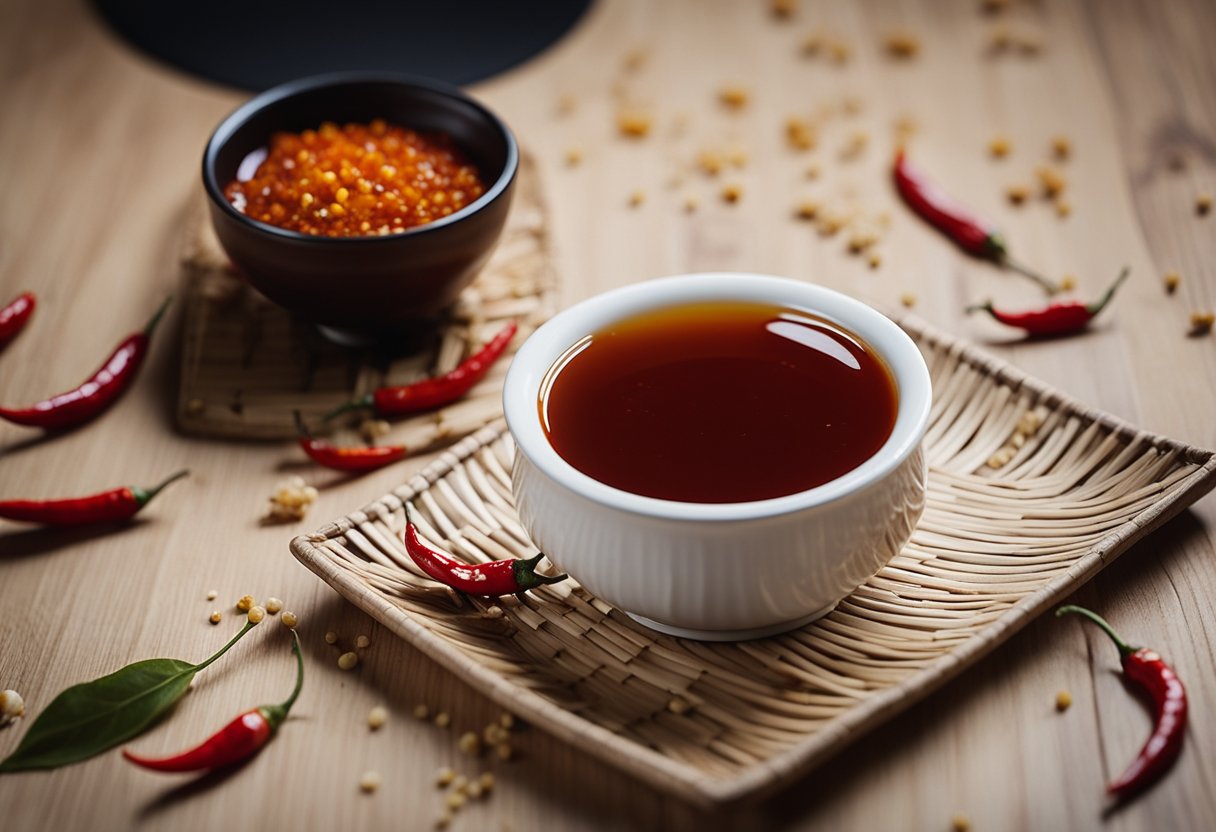
As a spicy condiment, chili oil is a staple in many Asian cuisines, particularly in Chinese and Sichuan cuisine.
It is made by infusing oil with chili peppers and other spices to create a flavorful and spicy sauce. The heat level of chili oil can vary depending on the type of chili peppers used and the amount of oil used in the recipe.
Chili peppers are the main ingredient in chili oil. They come in a variety of shapes, sizes, and heat levels.
Some popular varieties used in chili oil include Sichuan peppercorns, Thai bird’s eye chilies, and Korean gochugaru. These peppers are known for their intense heat and distinct flavor, which can range from sweet and fruity to smoky and earthy.
Oil is another essential ingredient in chili oil. It helps to mellow out the heat of the chili peppers and provides a smooth, rich texture.
Neutral oils such as vegetable, canola, or grapeseed oil are commonly used in chili oil recipes. However, some recipes call for more flavorful oils like sesame or peanut oil to add an extra layer of flavor to the sauce.
The flavor of chili oil is not just about the heat. It also contains a complex mix of spices that can include garlic, ginger, star anise, cinnamon, and more. These spices add depth and complexity to the sauce, making it more than just a one-note condiment.
Overall, chili oil is a versatile ingredient that can be used in a variety of dishes to add heat and flavor. Whether you’re making stir-fries, soups, or dipping sauces, chili oil is an excellent addition to any dish that could use a little extra kick.
Key Ingredients of Chili Oil
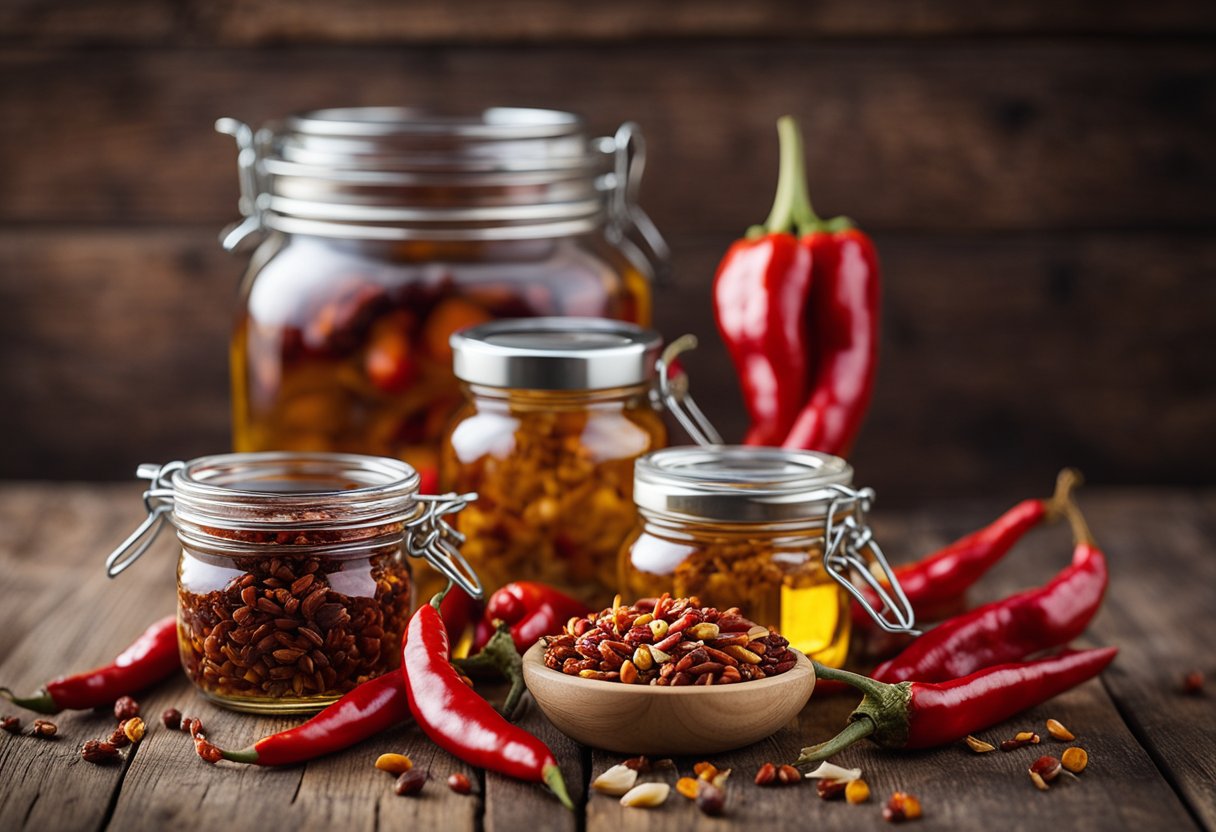
As someone who loves to cook, I know that chili oil is a staple ingredient in many recipes. However, there may be times when you don’t have any chili oil on hand or you want to try something new.
In these situations, it’s helpful to know about the key ingredients that make up chili oil and their potential substitutes.
Chili Flakes
Chili flakes are the primary ingredient in chili oil and provide the heat that gives the oil its signature flavor. If you don’t have chili flakes, you can substitute with cayenne pepper or paprika.
However, keep in mind that these substitutes may not provide the same level of heat as chili flakes.
Garlic
Garlic is another key ingredient in chili oil that provides a savory flavor and aroma. If you don’t have garlic, you can substitute with garlic powder or omit it altogether.
Salt
Salt is an essential ingredient in any recipe, including chili oil. If you don’t have salt, you can substitute with soy sauce or fish sauce.
Vinegar
Vinegar provides a tangy flavor to chili oil and helps to balance out the heat. If you don’t have vinegar, you can substitute with lemon juice or lime juice.
Sugar
Sugar is added to chili oil to balance out the heat and provide a slightly sweet flavor. If you don’t have sugar, you can substitute with honey or maple syrup.
Sesame Oil
Sesame oil provides a nutty flavor to chili oil and helps to round out the overall flavor profile. If you don’t have sesame oil, you can substitute with peanut oil or vegetable oil.
Dried Chili Peppers
Dried chili peppers are often used in the making of chili oil and provide a smoky, deep flavor. If you don’t have dried chili peppers, you can substitute with fresh chili peppers or chili paste.
Sichuan Pepper
Sichuan pepper is a key ingredient in Sichuan-style chili oil and provides a numbing sensation in addition to heat. If you don’t have Sichuan pepper, you can substitute with black pepper or cumin.
Fermented Soybeans
Fermented soybeans are often used in the making of chili oil and provide a savory, umami flavor. If you don’t have fermented soybeans, you can substitute with miso paste or soy sauce.
Knowing about these key ingredients and their potential substitutes can help you create a delicious chili oil even when you don’t have all the ingredients on hand.
Common Chili Oil Substitutes
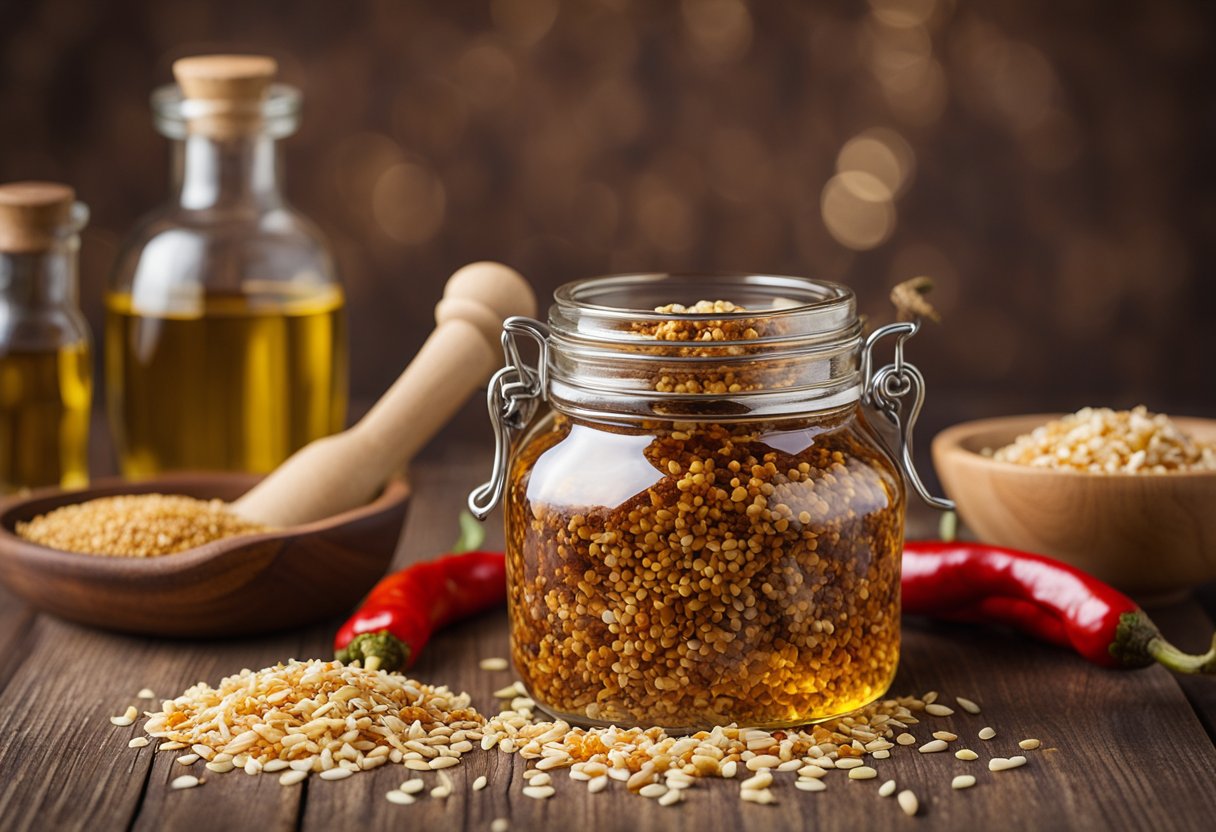
When you run out of chili oil, there are plenty of substitutes that you can use to add a spicy kick to your dishes.
Here are some of the most common chili oil substitutes that you can try:
Cayenne Pepper
Cayenne pepper is a popular chili pepper that is often used to make chili oil. It has a hot and spicy flavor that can add heat to any dish.
You can substitute chili oil with cayenne pepper by adding it to your dish while cooking. Start with a small amount and adjust according to your taste.
Chili Paste
Chili paste is another great substitute for chili oil. It is made by blending together dried chili peppers, garlic, salt, and oil.
You can make your own chili paste or buy it from the store. It has a thick consistency and a spicy flavor that can add depth to your dishes.
Sriracha
Sriracha is a popular hot sauce that is made from chili peppers, garlic, sugar, and vinegar. It has a sweet and spicy flavor that can be used as a substitute for chili oil. You can add sriracha to your dishes while cooking or use it as a condiment.
Sweet Chili Sauce
Sweet chili sauce is a popular sauce that is made from chili peppers, sugar, vinegar, and garlic. It has a sweet and spicy flavor that can be used as a substitute for chili oil. It can be used as a condiment or added to your dishes while cooking.
Gochujang
Gochujang is a Korean chili paste that is made from chili peppers, rice, and fermented soybeans. It has a thick consistency and a spicy flavor that can be used as a substitute for chili oil. It can be used as a condiment or added to your dishes while cooking.
Black Bean Sauce
Black bean sauce is a Chinese sauce that is made from fermented black beans, garlic, and chili peppers. It has a salty and spicy flavor that can be used as a substitute for chili oil. It can be used as a condiment or added to your dishes while cooking.
Sambal Oelek
Sambal oelek is an Indonesian chili paste that is made from chili peppers, vinegar, and salt. It has a spicy flavor that can be used as a substitute for chili oil. It can be used as a condiment or added to your dishes while cooking.
Red Chili Paste
Red chili paste is a Thai chili paste that is made from chili peppers, garlic, and shrimp paste. It has a spicy flavor that can be used as a substitute for chili oil. It can be used as a condiment or added to your dishes while cooking.
Chiu Chow Chili Oil
Chiu Chow chili oil is a Chinese chili oil that is made from chili peppers, garlic, and soy sauce. It has a spicy and savory flavor that can be used as a substitute for chili oil. It can be used as a condiment or added to your dishes while cooking.
Chili Garlic Sauce
Chili garlic sauce is a Chinese sauce that is made from chili peppers, garlic, vinegar, and sugar. It has a spicy and garlicky flavor that can be used as a substitute for chili oil. It can be used as a condiment or added to your dishes while cooking.
Spicy Soy Sauce
Spicy soy sauce is a Chinese sauce that is made from soy sauce, chili peppers, and garlic. It has a spicy and salty flavor that can be used as a substitute for chili oil. It can be used as a condiment or added to your dishes while cooking.
These are some of the most common chili oil substitutes that you can use in your dishes. Experiment with different substitutes to find the one that suits your taste.
Homemade Chili Oil
When it comes to making chili oil, nothing beats a homemade recipe. It’s easy to make and allows you to customize the flavor and heat level to your liking. Here’s a simple recipe that I like to use:
Ingredients
- 1 cup vegetable oil (you can also use peanut oil, canola oil, avocado oil, rapeseed oil, or sunflower oil)
- 1/4 cup dried chili flakes (you can also use fresh chilies, but you’ll need to adjust the amount to your taste)
- 1 teaspoon Sichuan peppercorns (optional)
- 1 inch ginger, sliced (optional)
- 2 cloves garlic, sliced (optional)
Instructions
- In a small saucepan, combine the oil, chili flakes, Sichuan peppercorns, ginger, and garlic.
- Heat the mixture over medium heat until it reaches 225°F, stirring occasionally.
- Remove from heat and let cool to room temperature.
- Strain the oil through a fine-mesh sieve into a clean jar or bottle.
- Store in the refrigerator for up to 1 month.
If you want a milder chili oil, you can remove the seeds from the chili flakes before adding them to the oil. You can also experiment with different types of dried peppers to achieve different flavors and heat levels.
Another option is to heat chilies in oil. This method involves heating fresh chilies in oil until they’re fragrant and slightly charred. You can then strain the oil and use it as a chili oil substitute.
When making homemade chili oil, it’s important to be careful with the heat. Wear gloves when handling hot peppers and make sure to keep the oil at a low temperature to prevent it from smoking or catching fire.
Overall, making your own chili oil is a great way to add flavor and heat to your dishes. It’s easy to customize and can be made with just a few simple ingredients. Plus, it’s a great way to use up any leftover dried peppers you may have on hand.
Using Substitutes in Different Dishes
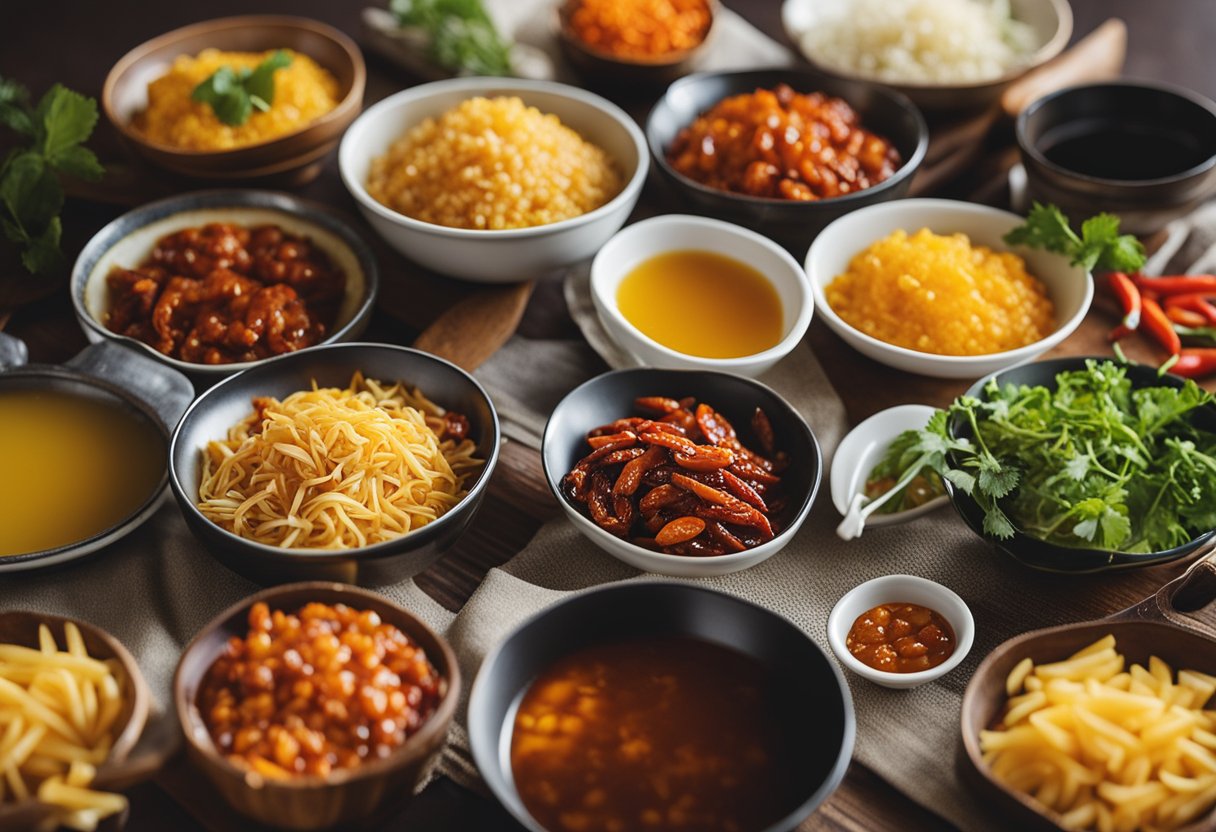
As a cooking enthusiast, I have tried different substitutes for chili oil in various dishes. Here are some of my go-to substitutes and how I use them in different dishes:
Dips and Dressings
When making dips and dressings, I like to use chili garlic oil as a substitute for chili oil. It adds a garlicky flavor to the dip and can be used in place of chili oil in recipes like hummus or ranch dressing.
Meat
For meat dishes like stir-fries or stews, I find that using Sichuan sauce is a great substitute for chili oil. It has a similar spicy flavor and can be used in marinades or as a finishing sauce.
Rice and Noodles
When cooking rice or noodles, I like to use chili flakes as a substitute for chili oil. It adds a nice kick of heat to the dish without overpowering the other flavors.
Soups and Stews
For soups and stews, I find that using hot sauce is a great substitute for chili oil. It adds a similar level of heat and can be used to adjust the spiciness of the dish to your liking.
Pasta
When making pasta dishes, I like to use cayenne pepper as a substitute for chili oil. It adds a similar level of heat and can be used in sauces or as a seasoning for the pasta.
Dumplings and Dim Sum
For dumplings and dim sum, I find that using sweet chili sauce is a great substitute for chili oil. It adds a sweet and spicy flavor that pairs well with the savory filling of the dumpling.
Scrambled Eggs
When making scrambled eggs, I like to use paprika as a substitute for chili oil. It adds a subtle smoky flavor and a hint of heat to the eggs.
Overall, there are many substitutes for chili oil that can be used in different dishes. By experimenting with different substitutes, you can find the perfect alternative that suits your taste preferences and cooking needs.
Pairing Chili Oil Substitutes with Other Ingredients
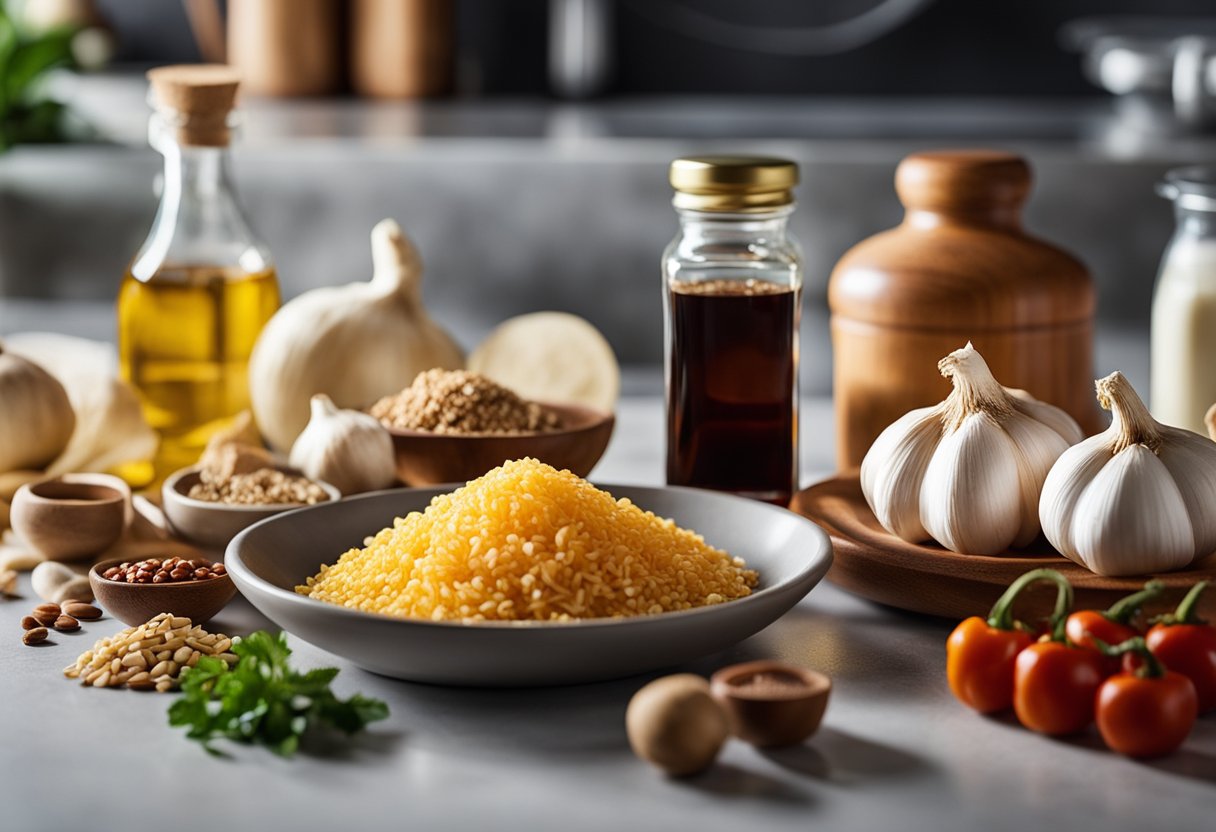
When substituting chili oil in a recipe, it’s important to consider what other ingredients you’re using. Some substitutes may work better with certain flavors or textures than others.
Here are some suggestions for pairing chili oil substitutes with other ingredients:
Sweet and Spicy
If you’re looking for a sweet and spicy flavor, consider using honey as a substitute for chili oil. Honey adds a touch of sweetness to your dish while still providing a spicy kick. This works well in marinades, dressings, and glazes.
Texture and Versatility
For a substitute that adds texture and versatility, try using peanuts. Peanut oil has a neutral flavor and can be used in a variety of dishes. It’s also a great way to add a crunchy texture to your meal. You can use it in stir-fries, sauces, and dressings.
Umami Flavor
If you’re looking for an umami flavor, try using soy sauce. Soy sauce has a salty, savory flavor that can add depth to your dish. It works well in marinades, stir-fries, and dipping sauces.
Spicy Flavor
For a substitute that still provides a spicy flavor, try using jalapenos. Fresh or pickled jalapenos can be used in place of chili oil to add heat to your dish. They work well in salsas, guacamole, and sandwiches.
Smokiness and Garlic Flavor
If you’re looking for a substitute that adds smokiness and garlic flavor, try using chipotle peppers in adobo sauce. The sauce has a smoky, spicy flavor with a hint of garlic. It’s great in marinades, sauces, and soups.
Sodium
If you’re watching your sodium intake, consider using low-sodium chicken or vegetable broth as a substitute for chili oil. It adds flavor without the added salt. You can use it in soups, stews, and sauces.
When substituting chili oil, keep in mind that the flavor and texture of the substitute may differ slightly from the original recipe.
It’s important to taste as you go and adjust the seasoning as needed. With these substitutes, you can still achieve a delicious and flavorful dish without using chili oil.
Culinary Uses of Chili Oil Substitutes
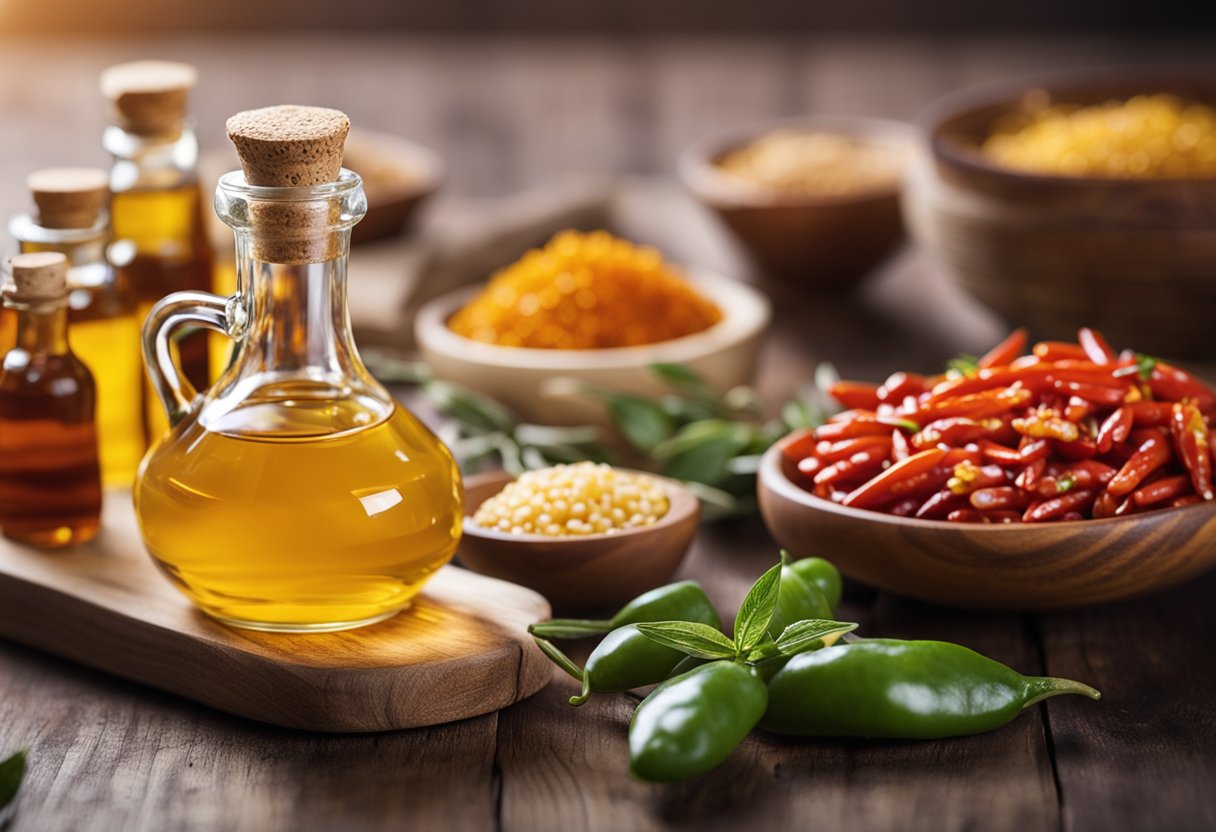
As a chili oil substitute, there are many ways to use different ingredients to add flavor and heat to your dishes.
Here are some culinary uses for chili oil substitutes:
- Condiment: Many chili oil substitutes can be used as a condiment, just like chili oil. For example, black bean sauce, chili garlic sauce, or sriracha can be used as a spread on sandwiches or as a dip for vegetables or meats.
- Marinade: A chili oil substitute can be used as a marinade for meats or vegetables. For instance, a mixture of neutral oil, dried pepper, and herbs can be used to marinate meats before grilling or roasting.
- Salsa Macha: Salsa Macha is a type of chili oil substitute from Southeast Asia that is made with dried chilies, garlic, and oil. It can be used as a sauce for tacos, burritos, or any other spicy food.
- Variations: There are many variations of chili oil substitutes that can be used in different dishes. For example, crushed red pepper can be used in pasta dishes, while cayenne pepper can be used in soups and stews.
Overall, chili oil substitutes can be used in many different ways in the kitchen. Whether you are looking for a condiment, marinade, or sauce, there is a chili oil substitute that can add heat and flavor to your dishes.
Considerations When Choosing a Substitute

When choosing a substitute for chili oil, there are several factors to consider. First and foremost, you should consider the flavor profile of the dish you are making.
Some substitutes, such as olive oil or paprika, may not provide the same level of heat as chili oil, but can still add depth and complexity to your dish.
If you are looking for a spicy substitute, red pepper flakes or chili powder can be a good choice. These substitutes can provide a similar level of heat as chili oil, but may lack the depth of flavor that chili oil provides.
Another factor to consider is the texture of the substitute. Some substitutes, such as chili garlic oil or hot chili oil, have a thicker texture than others, which can impact the overall texture of your dish.
If you are looking for a thinner substitute, sriracha sauce or a simple mixture of olive oil and red pepper flakes can be a good choice.
When it comes to specific substitutes, Sichuan peppercorn can be a good choice for those looking for a unique flavor profile. This spice has a numbing effect on the tongue and can add a complex, citrusy flavor to your dish.
Overall, the key to choosing a good substitute for chili oil is to experiment and find what works best for your specific dish and taste preferences.
Don’t be afraid to try different substitutes and adjust the amounts to get the perfect balance of heat and flavor.
Frequently Asked Questions
What is the difference between chili oil and chili sauce?
Chili oil is made by infusing oil with chili peppers and other spices, while chili sauce is a condiment made by blending chili peppers with other ingredients such as vinegar, sugar, and garlic.
Chili oil is typically used as a cooking ingredient or a condiment to add heat and flavor to dishes, while chili sauce is often used as a dipping sauce or a marinade.
How can I substitute chili paste for chili oil?
Chili paste is a thicker, more concentrated version of chili sauce that contains less liquid than chili oil. To substitute chili paste for chili oil, use a one-to-one ratio and adjust the amount according to your taste preferences.
Is chili garlic sauce the same as chili oil?
Chili garlic sauce is a type of chili sauce that contains garlic, vinegar, and sugar in addition to chili peppers. While chili garlic sauce can be used as a substitute for chili oil in some recipes, it has a different flavor profile and texture.
What type of oil is best for making chili oil?
Neutral oils such as vegetable oil, canola oil, or grapeseed oil are best for making chili oil because they do not have a strong flavor that will compete with the chili peppers. However, you can use any oil that you prefer.
How do you make chili infused oil?
To make chili infused oil, heat oil in a saucepan over low heat and add dried chili peppers. Cook the peppers for a few minutes until they become fragrant, then remove from heat and let cool. Strain the oil through a fine-mesh sieve and discard the peppers.
Can chili oil be used as a substitute for sriracha sauce?
While chili oil and sriracha sauce are both spicy condiments, they have different flavor profiles and textures.
Chili oil is made by infusing oil with chili peppers and other spices, while sriracha sauce is made by blending chili peppers, vinegar, sugar, and garlic.
While chili oil can be used as a substitute for sriracha sauce in some recipes, it will have a different taste and texture.







